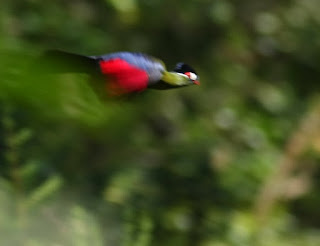Together
with him and another guide, who wanted to see some birds apparently, we
ventured to the famous Magamba Sawmill road, where all West-Usambara
specialties can be seen. To get here we hired motorbikes to get to Gologolo and
walked back until we could take a dalla-dalla back to Lushoto. We failed to
find all the endemics as we missed Usambara Weaver,
which seems to be very scarce as we continuously checked every lichen-covered
branch (the favoured feeding site of this species). However, we found some
interesting endemics by ourselves like Usambara Akalat, Spot-throat, African Tailorbird, Usambara
Double-collared Sunbird and Fülleborn´s Black Boubou.
 |
| Usambara Double-collared Sunbird (Cinnyrus usambaricus) |
Besides the endemics we saw several other good species including: Mountain Buzzard, Hartlaub´s Turaco, Klaas´s Cuckoo, Bar-tailed Trogon, Scaly-throated Honeyguide, Black-headed Mountain Greenbul (ssp. usambarae which might be its own species and then a new West-Usambara endemic), White-starred Robin, Black-fronted Bush-shrike, Sharpe´s and Kenrick´s Starling. Mammals observed included Angola Pied Colobus and Blue (or Sykes or White-throated) Monkey.
 |
| Hartlaub´s Turaco (Tauraco hartlaubi) delivering a splash of colour into the forest |
 |
| White-starred Robin (Pogonocichla stellata) |
really
liked the walk and the birding is good, especially in the morning near the old
sawmill, for the forest is, surprisingly enough, the best in this stretch.
However, I think seeing all the endemics without tape is near to impossible. As
stated above, Said might be a very decent guide in the future and a great
addition to the regions ¨normal¨ guides.


No comments:
Post a Comment